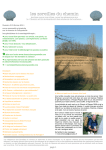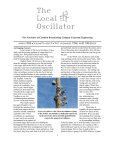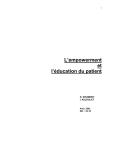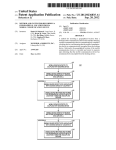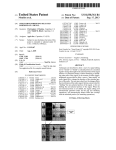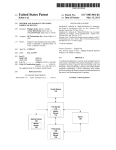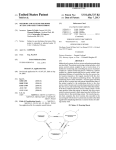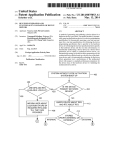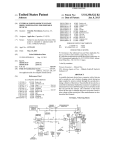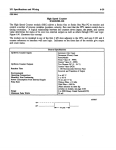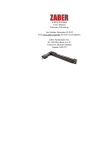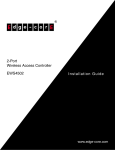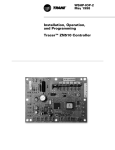Download Ethernet over coaxial coupling system, method and apparatus
Transcript
US008443406B2 (12) United States Patent (10) Patent N0.: (45) Date of Patent: Reed et a]. (54) ETHERNET OVER COAXIAL COUPLING (56) US 8,443,406 B2 May 14, 2013 References Cited SYSTEM, METHOD AND APPARATUS U.S. PATENT DOCUMENTS (75) Inventors: Vernon Reed, Austin, TX (US); Ahmad C. Ansari, Cedar Park, TX (US); David Rackley, Austin, TX (US) 5,355,096 A * 2005/0289632 A1* 10/1994 12/2005 2006/0010481 A1 2006/0225119 A1 1/2006 Wall et al. 10/2006 Wollmershauser et al. 2008/0018413 A1* (73) Assignee: AT&T Intellectual Property I, L.P., Atlanta, GA (US) Notice: Subject to any disclaimer, the term of this patent is extended or adjusted under 35 (74) Attorney, Agent, orFirm * Guntin & Gust, PLC; Jay H. Anderson Dec. 2, 2008 (65) (57) ABSTRACT A device that incorporates teachings of the present disclosure may include, for example, a controller to provide loW loss Prior Publication Data US 2010/0138880 A1 * cited by examiner Primary Examiner * Vivek Srivastava Assistant Examiner * Rong Le (21) Appl. No.: 12/326,666 Filed: Strull et al. ................. .. 333/132 OTHER PUBLICATIONS CTC union technologies co.,Ltd, EOC-20/2l user manual, Sep. 2008,Ver.0.9, sections: 1, 10.2, 10.3, 104* U.S.C. 154(b) by 719 days. (22) 1/2008 Kobayashi .................. .. 330/278 Brooks et al. ............... .. 725/126 connectivity to a plurality of coaxial ports over a broadband Jun. 3, 2010 range of frequencies in a coaxial network providing Ethernet networking, detune secondary coaxial splitters in the coaxial (51) Int. Cl. netWork that reduces an output-to-output isolation loss H04N 7/18 (52) US. Cl. USPC (58) among secondary coaxial splitter output ports, and enable re-distribution of modulated radio frequency video signals (2006.01) .......................................................... .. 725/78 Field of Classi?cation Search ..................... .. None from a point on the coaxial netWork to any alternative point on the coaxial netWork. Other embodiments are disclosed. See application ?le for complete search history. 18 Claims, 5 Drawing Sheets 602 Ethernet Over-Coax Low toss spimar f612 i ' Low loss palh 608 Broadband Gateway" Router 0O I07 US. Patent May 14, 2013 Sheet 1 of5 US 8,443,406 B2 130 L ACCESS NETWORK Satellite receiver m dish Y g N- - ISP Ntwk Q <—, Cable TV 133 Services US. Patent May 14, 2013 Sheet 2 of5 PORTAL US 8,443,406 B2 /‘ 202 http://wwwmyportaLoom/ I DVR I I IMS Services I I VoD Catalog I Ilnternet ServicesI I EPG I ICollphone ServicesI O : ~"..I~'|. 20o “““““ 2 :=-:: Media Processor Communication Devices Keypad M ‘q "5' ‘.: Transceiver E Location Receiver l Display 31_() Controller @ Audio System w Image sensor m E 4 4 A FIG. 3 I I I Power Supply M @ US. Patent May 14, 2013 Sheet 3 of5 US 8,443,406 B2 Purposely creating a port impedance mismatch in a splitter for improved Ethernet Detuning any secondary networking over coaxial cables in a coaxial network, wherein the port impedance mismatch causes a slightly lower power V transfer to each leg of the splitter and a higher return loss figure (as long as the return loss figure is maintained under splitter coupled to the coaxial network, wherein the detuning of any secondary splitter results in reduced output port isolation among output ports in the secondary splitter @ tOdB) 49g Devices coupled to the " secondary splitter output ports Enabling distribution of observe less path loss modulated radio frequency between them enabling video over the coaxial network Ethernet over Coaxial cable 4 to deliver analog video to a technologies to operate with a higher data rate or improved signal-to-noise ratio or both plurality of repeater devices coupled to the coaxial network §_0_6 51% Supporting connection of radio frequency modulated video Maintaining low loss at higher frequency ranges by using sources onto the coaxial cable bypass capacitors at each network enabling-re distribution of analog television signals to other locations within a premise over the coaxial cable network iL resistor in the splitter or ' secondary splitter to establish a flat or custom frequency response profile M gm FIG. 4 US. Patent May 14, 2013 Sheet 4 of5 US 8,443,406 B2 Processor Video _ = > < 7 Display Instructions -—\ E m 524 Main Memory Alpha-Numeric 4 > Instructions r~\ M < Input ' Device 512 524 ‘Static Memory Instructions ~ Cursor Control 4 > < > Device 51_4 \ 524 Machine Readable Network Interface I : Medium Device 2 u //‘ Instructions 524 523 516 Q. Network _ Signal Generation < > Device 5L m FIG. 5 US. Patent May 14, 2013 U. K Sheet 5 of5 US 8,443,406 B2 U r624 R}: Mlxlulateu fed, TV c 1- n‘ W1 652E534; 620 Caax came EOC-enabied a m Etherneitiakx‘e 4 r ‘3e Ekhsmei Over-Coax Low was sputter 3:55,. W K 61 2 " Low loss path 608 EihemekOv M2021 (E00; 5:494 \ . """"" Brcadband .4, Gateway! Route!’ @ FIG. 6 61 0 " " US 8,443,406 B2 1 2 ETHERNET OVER COAXIAL COUPLING operating in a home coaxial network resulting in the detuning of a secondary splitter coupled to the home coaxial network, detuning a secondary splitter coupled to the coaxial network, SYSTEM, METHOD AND APPARATUS and enabling distribution of modulated video over the home coaxial network to deliver analog video to a plurality of repeater devices coupled to the home coaxial network. Yet another embodiment of the present disclosure can entail a device having a controller to provide low loss con nectivity to a plurality of coaxial ports over a broadband range of frequencies in a coaxial network providing Ethernet net FIELD OF THE DISCLOSURE The present disclosure relates generally to coupling devices and more speci?cally to support an Ethemet-Over Coax (EOC) technology coupling system, method, and device. working, detune secondary coaxial splitters in the coaxial BACKGROUND network that reduces an output-to-output isolation loss among secondary coaxial splitter output ports, and enable re-distribution of modulated radio frequency video signals Coaxial splitters were implemented by cable companies as a means of providing analog cable signals to multiple televi sion units within a home. However, due to imperfections in a from a point on the coaxial network to any alternative point on cable plant or intermediate network elements, analog signals the coaxial network. Yet another embodiment of the present disclosure can entail a device having a splitter providing low loss connec tivity to a plurality of coaxial ports over a range of frequencies in a coaxial network by having a port impedance mismatch that causes a lower power transfer to each leg of the splitter and a higher return loss relative to an impedance matched splitter. The splitter can be constructed to detune a secondary coaxial splitter when coupled in an Ethernet over coaxial network and constructed to reduce an output-to-output isola can “re?ect” from one coaxial path back onto an adjacent path causing “Ghost TV images.” Because of the ghost image problem, splitter designs have evolved to incorporate a high signal isolation between their output ports to suppress the 20 signal re?ections (and ghost images). The evolution of Internet Protocol (IP) networking tech nologies today makes it possible to deliver video (as well as voice and data) over these new networks, leveraging also the ability to map packet-based data onto a variety of Ethernet over Coax (EOC) network technologies (e.g., Home Phone Line Network Assn., or HPNA; Multimedia over Coax Assn., or MoCA, or other similar competing solutions that permit the use of existing coax to deliver IP-network data throughout the home without rewiring). Unfortunately, use of the tradi tional Cable-TV splitter devices as part of EOC networks can severely impair achievable data rates between devices attached to the output ports because of the high design isola tion of the legacy home network design that utiliZes high isolation splitters. 25 tion loss among secondary coaxial splitter output ports when coupled in the Ethernet over coaxial network. FIG. 1 depicts an illustrative embodiment of a ?rst com munication system 100 for delivering media content. The 30 col Television (IPTV) broadcast media system. The IPTV media system can include a super head-end of?ce (SHO) 110 with at least one super headend o?ice server (SHS) 111 which receives media content from satellite and/or terrestrial com 35 BRIEF DESCRIPTION OF THE DRAWINGS 40 The VHS 114 can distribute multimedia broadcast pro grams via an access network 118 to commercial and/or resi acting with the communication system of FIG. 1; FIG. 3 depicts an illustrative embodiment of a communi dential buildings 102 housing a gateway 104 (such as a com cation device utiliZed in the communication system of FIG. 1; 45 operating in portions of the communication system of FIG. 1; FIG. 5 is a diagrammatic representation of a machine in the form of a computer system within which a set of instructions, when executed, may cause the machine to perform any one or 50 DETAILED DESCRIPTION 55 as coaxial or phone line wiring) or can operate over a common 60 the home coaxial network, and enabling distribution of modu lated radio frequency video over the home coaxial network to deliver analog video to a plurality of repeater devices coupled tions for creating a port impedance mismatch in a splitter 108 such as computers or television sets managed in some instances by a media controller 107 (such as an infrared or RF remote control). The gateway 104, the media processors 106, and media devices 108 can utiliZe tethered interface technologies (such method involving setting a port impedance mismatch in a splitter for Ethernet networking over coaxial cables in a home computer-readable storage medium having computer instruc gateway 104 can use common communication technology to distribute IP-based media signals to media processors 106 such as Set-Top Boxes (STBs) using an EOC technology which in turn present broadcast channels to media devices One embodiment of the present disclosure can entail a to the home coaxial network. Another embodiment of the present disclosure can entail a mon residential or commercial gateway). The access network 118 can represent a group of digital subscriber line access multiplexers (DSLAMs) located in a central o?ice or a ser vice area interface that provide broadband services over opti cal links or copper twisted pairs 119 to buildings 102. The more of the methodologies discussed herein; and FIG. 6 is an illustration of a system using a splitter having a port impedance mismatch for Ethernet networking over coaxial cables in accordance with the embodiments herein. coaxial network, detuning any secondary splitter coupled to video head-end o?ices (VH0) 112 according to a common multicast communication protocol. FIG. 2 depicts an illustrative embodiment of a portal inter FIG. 4 depicts an illustrative embodiment of a method munication systems. In the present context, media content can represent audio content, moving image content such as videos, still image content, or combinations thereof. The SHS server 111 can forward packets associated with the media content to video head-end servers (VHS) 114 via a network of FIG. 1 depicts an illustrative embodiment of a communi cation system; communication system 100 can represent an Internet Proto wireless access protocol. With these interfaces, unicast or multicast IP communications can be invoked between the media processors 106 and subsystems of the IPTV media system for services such as video-on-demand (VoD), brows ing an electronic programming guide (EPG), or other infra 65 structure services. Some of the network elements of the IPTV media system can be coupled to one or more computing devices 130 a US 8,443,406 B2 4 3 portion of Which can operate as a Web server for providing portal services over an Internet Service Provider (ISP) net Work 132 to Wireline media devices 108 or Wireless commu The UI 304 can include a depressible or touch-sensitive keypad 3 08 With a navigation mechanism such as a roller ball, joystick, mouse, or navigation disk for manipulating opera nication devices 116 directly or indirectly by Way of a Wire less access base station 117 operating according to common Wireless access protocols such as Wireless Fidelity (WiFi), or tions of the communication device 300. The keypad 308 can be an integral part of a housing assembly of the communica tion device 300 or an independent device operably coupled thereto by a tethered Wireline interface (such as a USB cable) or a Wireless interface supporting for example Bluetooth. The keypad 308 can represent a numeric dialing keypad com cellular communication technologies (such as GSM, CDMA, UMTS, WiMAX, Software De?ned Radio or SDR, and so on). monly used by phones, and/or a Qwerty keypad With alpha It Will be appreciated by an artisan of ordinary skill in the place of the IPTV media system. In this embodiment, signals numeric keys. The UI 304 can further include a display 310 such as monochrome or color LCD (Liquid Crystal Display), transmitted by a satellite 115 supplying media content can be intercepted by a common satellite dish receiver 131 coupled play technology for conveying images to an end user of the to the building 102. Modulated signals intercepted by the communication device 300. In an embodiment Where the satellite dish receiver 131 can be submitted to the digital display 310 is touch-sensitive, a portion or all of the keypad 308 can be presented by Way of the display. art that a satellite broadcast television system can be used in OLED (Organic Light Emitting Diode) or other suitable dis media processors 106 for generating broadcast channels Which can be presented at the media devices 108. The media processors 106 can be equipped With a broadband port to the ISP netWork 132 to enable infrastructure services such asVoD and EPG described above. The UI 304 can also include an audio system 312 that 20 utiliZes common audio technology for conveying loW volume audio (such as audio heard only in the proximity of a human ear) and high volume audio (such as speakerphone for hands In yet another embodiment, an analog or digital broadcast free operation). The audio system 312 can further include a distribution system such as cable TV system 133 can be used microphone for receiving audible signals of an end user. The in place of the IPTV media system described above. In this embodiment the cable TV system 133 can provide Internet, telephony, and interactive media services under conditions Where the ECO technology and cable or satellite service frequency use does not overlap. It folloWs from the above illustrations that the present 25 UI 304 can further include an image sensor 313 such as a charged coupled device (CCD) camera for capturing still or moving images. The poWer supply 314 can utiliZe common poWer manage ment technologies such as replaceable and rechargeable bat 30 disclosure can apply to any present or future interactive media content services. FIG. 2 depicts an illustrative embodiment of a portal 202 Which can operate from the computing devices 130 described earlier of communication 100 illustrated in FIG. 1. The portal 202 can be used for managing services of communication systems 100-200. The portal 202 can be accessed by a Uni form Resource Locator (URL) With a common Internet broWser such as Microsoft’s Internet ExplorerTM using an Internet-capable communication device such as those described for FIGS. 1-2. The portal 202 can be con?gured, for communication device 300 to facilitate long-range or short 35 40 example, to access a media processor 106 and services man aged thereby such as a Digital Video Recorder (DVR), a VoD catalog, an EPG, a personal catalog (such as personal videos, pictures, audio recordings, etc.) stored in the media processor, provisioning IMS services described earlier, provisioning Internet services, provisioning cellular phone services, and so 45 on. FIG. 3 depicts an exemplary embodiment of a communi cation device 300. Communication 300 can serve in Whole or 50 in part as an illustrative embodiment of the communication devices of FIGS. 1-2. The communication device 300 can comprise a Wireline and/or Wireless transceiver 302 (herein transceiver 302), a user interface (UI) 304, a poWer supply 314, a location receiver 316, and a controller 306 for manag ing operations thereof. The transceiver 302 can support short 55 60 associated storage memory such a Flash, ROM, RAM, SRAM, DRAM or other storage technologies. The communication device 300 can be adapted to perform the functions of the media processor 106, the media devices 108, or the portable communication devices 116 of FIG. 1. It Will be appreciated that the communication device 300 can also represent other common devices that can operate in communication systems 100 of FIG. 1 such as a gaming console and a media player. FIG. 4 depicts an illustrative method 400 that operates in portions of the communication system of FIG. 1. Method 400 can begin With step 402 in Which the method purposely cre ates a port impedance mismatch in a splitter for improved Ethernet netWorking over coaxial cables in a coaxial netWork under a 10 dB loss. The method 400 at 404 can detune any secondary splitter coupled to the coaxial netWork Where the detuning of any secondary splitter results in a reduced output port isolation among output ports in the secondary splitter. Note that the secondary splitters are assumed to be impedance example, CDMA-lX, UMTS/HSDPA, GSM/GPRS, TDMA/ EDGE, EV/DO, WiMAX, SDR, and next generation cellular TCPIP, VoIP, etc.), and combinations thereof. location services such as navigation. The controller 306 can utiliZe computing technologies such as a microprocessor, a digital signal processor (DSP), and/ or a video processor With such as a home coaxial netWork or a coaxial netWork in an Bluetooth, WiFi, Digital Enhanced Cordless Telecommuni Wireless communication technologies as they arise. The transceiver 402 can also be adapted to support circuit sWitched Wireline access technologies (such as PSTN), packet-sWitched Wireline access technologies (such as range portable applications. The location receiver 316 can utiliZe common location technology such as a global posi tioning system (GPS) receiver for identifying a location of the communication device 100 based on signals generated by a constellation of GPS satellites, thereby facilitating common o?ice setting. The port impedance mismatch causes a slightly loWer poWer transfer to each leg of the splitter and a higher return loss ?gure. The return loss ?gure generally should be range or long-range Wireless access technologies such as cations (DECT), or cellular communication technologies, just to mention a feW. Cellular technologies can include, for teries, supply regulation technologies, and charging system technologies for supplying energy to the components of the 65 matched to a coaxial cable at 75 Ohms for example and an input to the splitter can be an IPTV or iTV input signal. At 406, the method can enable distribution of modulated radio US 8,443,406 B2 5 6 frequency (RF) video over the home coaxial network to deliver analog video to a plurality of repeater devices coupled to the home coaxial network. all terminations are impedance matched to the coax (in this Devices coupled to the secondary splitter output ports impedance of either higher or lower than 75 ohms (predeter mined impedance match), the net effect is a slightly less power transfer to each leg of the splitter, at the expense of somewhat higher than desired return loss ?gure. However, the observe less path loss between them enabling Ethernet over Coaxial cable technologies to operate with a higher data rate or improved signal-to-noise ratio or both at 408. Note that the splitter can minimiZe splitter losses in all directions while enable operations over the coaxial cable at frequencies up to 1 GigahertZ or higher. At 410, the splitter can support con nection of radio frequency modulated video sources onto the case RG-59 or RG-6 is at 75 ohms). By purposely designing the splitter to represent a port port mismatch this creates propagates through the coax to an 10 tional splitter is ‘detuned’ from its design optimum, resulting coaxial cable network enabling re-distribution of analog tele in reduced output port isolation in the output ports of the vision signals to other locations within a home over the coaxial cable network. The method 400 maintains low loss at higher frequency ranges by using bypass capacitors at each 15 resistor in the splitter or secondary splitter to establish a ?at or custom frequency response pro?le at 412. get completely out ofhand (e.g., <10 dB). 20 without departing from the scope and spirit of the claims described below. For example, the network is not limited to a home coaxial network, but can be con?gured for use in of?ce The embodiments herein further include a new coaxial 25 splitter design that will serve not only to minimize the point to-point loss that affects all existing EOC technologies, but also enables devices using these technologies to communi 30 where, and also permit the distribution of modulated RF video on the coax network to deliver analog video to video repeater devices (2 or more secondary televisions) throughout the home, dwelling or building. This device performs all three of these functions simultaneously once installed at the “Main The splitter device can be designed to minimiZe splitter losses in all directions, and also at frequencies up to approxi mately 1 GHZ (or higher) in order to support connection of RF modulated video sources onto the coax plant in a way that or building scenarios and multi-dwelling units. cate in all directions with minimal loss, to detune any second ary splitter that may be hidden in the wall or attic or else secondary splitter(s). Devices attached to the secondary split ter outputs thereby observe less path loss between them, making EOC technologies operate with higher rate or improved signal to noise ratios (or both). This effect works extremely well as long as return loss ?gures are not allowed to Upon reviewing the aforementioned embodiments, it would be evident to an artisan with ordinary skill in the art that said embodiments can be modi?ed, reduced, or enhanced embedded splitter which results in a mismatch at its input port. As a result, the internal circuitry of a secondary conven 35 Home Splitter” location. An impedance-matching purely resistive splitter is typi cally designed based on the following formula: permits re-distribution of the analog TV signal to other loca tion is a premise (whether a home, o?ice, or other structure). Maintaining low loss at higher frequency may be achieved using bypass capacitors at each resistor to establish a ?at or custom frequency response pro?le. Current test units have demonstrated support for EOC and RF signals up to 1.5 GHZ. Since most RF modulators provide output signal levels of + 1 5 to +23 dBmV, and television receivers expect to have signal levels of at least —8 dBmV, the loss budget for the new splitter is between 23 and 31 dB for good quality video distribution. The splitter in accordance with the embodiments herein can exhibit even in a 1:6 con?guration, losses in the 14 dB range in a worst case scenario. This relatively low loss easily per mits RF distribution even in quite large homes or buildings. Other suitable modi?cations can be applied to the present disclosure without departing from the scope of the claims 40 below. Accordingly, the reader is directed to the claims sec tion for a fuller understanding of the breadth and scope of the present disclosure. FIG. 5 depicts an exemplary diagrammatic representation where ZILoad Impedance (e. g., 75 ohms), and N:Total # of splitter ports However, a purely resistive splitter which looks like the following schematically: 45 of a machine in the form of a computer system 500 within which a set of instructions, when executed, may cause the machine to perform any one or more of the methodologies discussed above. In some embodiments, the machine oper 2552 F-Connector F-Connector F-Connector 2552 Rint These equations and schematics may be expanded to accom- 65 ates as a standalone device. In some embodiments, the modate many additional port con?gurations (e.g., 1:3, 1:4, 1:5, 1 :6, etc.). Note however that the above example assumed machine may be connected (e.g., using a network) to other machines. In a networked deployment, the machine may US 8,443,406 B2 8 7 While the machine-readable medium 522 is shown in an operate in the capacity of a server or a client user machine in server-client user network environment, or as a peer machine example embodiment to be a single medium, the term in a peer-to-peer (or distributed) network environment. “machine-readable medium” should be taken to include a single medium or multiple media (e.g., a centraliZed or dis The machine may comprise a server computer, a client user tributed database, and/or associated caches and servers) that computer, a personal computer (PC), a tablet PC, a laptop computer, a desktop computer, a control system, a network store the one or more sets of instructions. The term “machine router, switch or bridge, or any machine capable of executing a set of instructions (sequential or otherwise) that specify actions to be taken by that machine. It will be understood that a device of the present disclosure includes broadly any elec tronic device that provides voice, video or data communica tion. Further, while a single machine is illustrated, the term “machine” shall also be taken to include any collection of machines that individually or jointly execute a set (or multiple readable medium” shall also be taken to include any medium sets) of instructions to perform any one or more of the meth point-to-point loss that affects all existing EOC technologies, that is capable of storing, encoding or carrying a set of instruc tions for execution by the machine and that cause the machine to perform any one or more of the methodologies of the present disclosure. FIG. 6 depicts an exemplary diagrammatic representation of a system 600 in a premise 602 such as a home or o?ice where the new coaxial splitter design as contemplated herein in the form of splitter 608 can serve not only to minimize the odologies discussed herein. but also enables devices using these technologies to commu nicate in all directions with minimal loss, to detune any sec The computer system 500 may include a processor 502 (e.g., a central processing unit (CPU), a graphics processing unit (GPU, or both), a main memory 504 and a static memory 506, which communicate with each other via a bus 508. The computer system 500 may further include a video display unit 510 (e.g., a liquid crystal display (LCD), a ?at panel, a solid state display, or a cathode ray tube (CRT)). The computer system 500 may include an input device 512 (e.g., a key ondary splitter such as secondary splitter 614 that may be 20 hidden in the wall or attic or elsewhere, and also permit the distribution of modulated RF video on the coax network to deliver analog video to video repeater devices (2 or more secondary televisions such as TV 624) throughout the home, dwelling or building. 25 board), a cursor control device 514 (e.g., a mouse), a disk drive unit 516, a signal generation device 518 (e.g., a speaker As illustrated, the system 600 can include a broadband gateway or router 604 coupled to an EOC bridge 606 over an tions (e.g., software 524) embodying any one or more of the Ethernet cable. The bridge 606 feeds a signal to the EOC low loss splitter 608 as contemplated in the embodiments herein. The splitter 608 can have low loss paths in multiple directions including a path to an EOC-enabled set top box (STB) or digital video recorder 610 that is coupled to TV 612 or a path methodologies or functions described herein, including those to the secondary splitter 614. Since the secondary splitter 614 methods illustrated above. The instructions 524 may also reside, completely or at least partially, within the main memory 504, the static memory 506, and/or within the pro is detuned as discussed above, other EOC-enabled devices (such as EOC-enabled STE 616 and EOC-enabled Bridge or remote control) and a network interface device 520. The disk drive unit 516 may include a machine-readable medium 522 on which is stored one or more sets of instruc 30 35 620 and their respective presentation devices 618 and 622) cessor 502 during execution thereof by the computer system will operate without signi?cant or perceptible detriment to 500. The main memory 504 and the processor 502 also may constitute machine-readable media. the end user. The term “machine-readable medium” shall accordingly be taken to include, but not be limited to: solid-state memories Dedicated hardware implementations including, but not limited to, application speci?c integrated circuits, program 40 such as a memory card or other package that houses one or mable logic arrays and other hardware devices can likewise be constructed to implement the methods described herein. more read-only (non-volatile) memories, random access memories, or other re-writable (volatile) memories; mag Applications that may include the apparatus and systems of various embodiments broadly include a variety of electronic and computer systems. Some embodiments implement func neto-optical or optical medium such as a disk or tape; and/or a digital ?le attachment to e-mail or other self-contained information archive or set of archives is considered a distri 45 bution medium equivalent to a tangible storage medium. tions in two or more speci?c interconnected hardware mod ules or devices with related control and data signals commu nicated between and through the modules, or as portions of an Accordingly, the disclosure is considered to include any one or more of a machine-readable medium or a distribution application-speci?c integrated circuit. Thus, the example sys tem is applicable to software, ?rmware, and hardware imple mentations. In accordance with various embodiments of the present disclosure, the methods described herein are intended for operation as software programs running on a computer pro cessor. Furthermore, software implementations can include, but not limited to, distributed processing or component/ obj ect 50 implementations herein are stored. Although the present speci?cation describes components 55 distributed processing, parallel processing, or virtual machine processing can also be constructed to implement the methods described herein. The present disclosure contemplates a machine readable medium containing instructions 524, or that which receives and executes instructions 524 from a propagated signal so that medium, as listed herein and including art-recognized equivalents and successor media, in which the software and functions implemented in the embodiments with refer ence to particular standards and protocols, the disclosure is not limited to such standards and protocols. Each of the standards for Internet and other packet switched network transmission (e.g., TCP/IP, UDP/IP, HTML, HTTP) represent examples of the state of the art. Such standards are periodi cally superseded by faster or more ef?cient equivalents hav 60 ing essentially the same functions. Accordingly, replacement standards and protocols having the same functions are con sidered equivalents. a device connected to a network environment 526 can send or The illustrations of embodiments described herein are receive voice, video or data, and to communicate over the intended to provide a general understanding of the structure network 526 using the instructions 524. The instructions 524 may further be transmitted or received over a network 526 via the network interface device 520. 65 of various embodiments, and they are not intended to serve as a complete description of all the elements and features of apparatus and systems that might make use of the structures US 8,443,406 B2 9 10 described herein. Many other embodiments will be apparent to those of skill in the art upon reviewing the above descrip 4. The method of claim 1, wherein the mismatch causes a reduction in power transfer from an input port of the primary splitter to the output port of the primary splitter and an increase in return loss ?gure relative to the second impedance tion. Other embodiments may be utilized and derived there from, such that structural and logical substitutions and changes may be made without departing from the scope of this disclosure. Figures are also merely representational and of the input port of the secondary splitter. 5. The method of claim 4, wherein the return loss ?gure is maintained under 10 dB. 6. The method of claim 1, wherein devices coupled to the may not be drawn to scale. Certain proportions thereof may be exaggerated, while others may be minimized. Accord ingly, the speci?cation and drawings are to be regarded in an secondary splitter ?rst and second output ports observe less illustrative rather than a restrictive sense. path loss between them enabling Ethernet over Coaxial cable technologies to operate with a higher data rate, improving signal-to-noise ratios, or both. 7. The method of claim 1, wherein the primary splitter reduces splitter losses in all directions while enabling opera Such embodiments of the inventive subject matter may be referred to herein, individually and/or collectively, by the term “invention” merely for convenience and without intend ing to voluntarily limit the scope of this application to any single invention or inventive concept if more than one is in fact disclosed. Thus, although speci?c embodiments have been illustrated and described herein, it shouldbe appreciated tions over the home coaxial network at frequencies up to 2 that any arrangement calculated to achieve the same purpose 8. The method of claim 7, wherein the primary splitter supports connection of radio frequency modulated video Giga-HertZ. may be substituted for the speci?c embodiments shown. This disclosure is intended to cover any and all adaptations or 20 variations of various embodiments. Combinations of the above embodiments, and other embodiments not speci?cally described herein, will be apparent to those of skill in the art sources onto the home coaxial network enabling re-distribu tion of analog television signals to other locations within a home over the home coaxial network. 9. A non-transitory computer-readable storage medium, comprising computer instructions which, when executed by upon reviewing the above description. The Abstract of the Disclosure is provided to comply with 37 C.F.R. §l .72(b), requiring an abstract that will allow the reader to quickly ascertain the nature of the technical disclo 25 at least one processor, cause the at least one processor to sure. It is submitted with the understanding that it will not be used to interpret or limit the scope or meaning of the claims. ?rst impedance to cause a mismatch with a second In addition, in the foregoing Detailed Description, it can be perform operations for: setting an output port impedance of a primary splitter to a impedance of an input port of a secondary splitter and to 30 embodiment for the purpose of streamlining the disclosure. This method of disclosure is not to be interpreted as re?ecting an intention that the claimed embodiments require more fea tures than are expressly recited in each claim. Rather, as the cause an increased return loss and a reduced output port isolation, wherein the primary splitter is coupled to the secondary splitter by way of a home coaxial network, seen that various features are grouped together in a single and wherein the mismatch causes a reduction in signal isolation between ?rst and second output ports of the 35 secondary splitter; following claims re?ect, inventive subject matter lies in less bypassing via a capacitor each resistor of a plurality of than all features of a single disclosed embodiment. Thus the resistors in the primary splitter and in the secondary splitter; and enabling from the primary splitter distribution of Ethernet following claims are hereby incorporated into the Detailed Description, with each claim standing on its own as a sepa rately claimed subject matter. 40 What is claimed is: 1. A method, comprising: setting an output port of a primary splitter to a ?rst imped ance to cause a mismatch with a second impedance of an input port of a secondary splitter and to cause an increased return loss and a reduced output port isolation, 45 output ports. 10. A method, comprising: causing output ports of a primary splitter to have an imped wherein the primary splitter is coupled to the secondary splitter by way of coaxial cables in a home coaxial network; detuning the secondary splitter coupled to the home signals to devices coupled to the home coaxial network by way of ?rst and second output ports of the secondary splitter, wherein signal to noise ratios of the Ethernet signals distributed from the ?rst and second output ports of the secondary splitter are improved responsive to the reduction in signal isolation between ?rst and second 50 coaxial network responsive to the mismatch thereby ance mismatch with a plurality of coaxial input ports of secondary splitters over a broadband range of frequen cies in a coaxial network providing Ethernet networking causing a reduction in a signal isolation between ?rst and causing an increased return loss and a reduced out and second output ports of the secondary splitter; put port isolation; detuning secondary splitters in the coaxial network respon bypassing via a capacitor each resistor of a plurality of resistors in the primary splitter and in the secondary 55 splitter to establish at least one of a ?at pro?le, a custom secondary splitters; pro?le, or a combination thereof; and distributing from the primary splitter Ethernet signals over the home coaxial network to devices coupled to the home coaxial network by way of the ?rst and second bypassing via a capacitor each resistor of a plurality of 60 output ports of the secondary splitter. 2. The method of claim 1, wherein the secondary splitter is 3. The method of claim 2, wherein the secondary splitter is impedance matched to a coaxial cable at 75 Ohms and the as Ethernet signals over the home coaxial network. resistors in the primary splitter and in the secondary splitter; and distributing Ethernet signals from the output ports of the secondary splitters responsive to the detuning of the secondary splitters. impedance matched to a coaxial cable. primary splitter receives as an input a media signal distributed sive to the impedance mismatch thereby reducing an output-to-output isolation loss among output ports of the 65 11. The method of claim 10, wherein the broadband range of frequencies is from DC. to 2 Giga-HertZ, and wherein the coaxial input ports of the secondary splitters are matched to a coaxial cable at 75 Ohms. US 8,443,406 B2 11 12 port of the primary splitter to an output port of the primary splitter and a higher return loss ?gure relative to 12. The method of claim 10, wherein the mismatch causes a lower power transfer from an input port of the primary the input impedance of the secondary splitter, wherein splitter to the output ports of the primary splitter and a higher return loss ?gure. 13. The method of claim 12, wherein the primary splitter supports transmission of radio frequency modulated video sources onto the coaxial cable network enabling re-distribu tion of analog television signals to other locations within a home over the coaxial cable network. 14. The method of claim 1 0, wherein devices coupled to the 10 output ports of the secondary splitters observe less path loss between them enabling Ethernet over Coaxial cable technolo gies to operate with a higher data rate or improved signal-to noise ratio or both as long as the return loss ?gure is main tained under 10 dB. tive point on the coaxial network. 17. The device of claim 15, wherein devices coupled to the ?rst and second output ports of the secondary splitter observe less path loss between them enabling Ethernet over Coaxial 15. A device, comprising: a primary splitter comprising: cable technologies to operate with a higher data rate or an output impedance that is mismatch with an input imped ance of an input port of a secondary splitter to cause an increased return loss and a reduced output port isolation; and a plurality of capacitors each bypassing each resistor of a plurality of resistors of primary splitter, wherein the mismatch causes a lower power transfer from an input the primary splitter is constructed to have an impedance mismatch with the secondary splitter to cause a detuning of the secondary splitter to reduce an output-to-output isolation loss among ?rst and second output ports of the secondary splitter when coupled in an Ethernet over coaxial network. 16. The device of claim 15, wherein the primary splitter enables re-distribution of modulated radio frequency video signals from any point on the coaxial network to any altema 20 improved signal-to-noise ratio or both. 18. The device of claim 15, wherein the primary splitter supports transmission of radio frequency modulated video sources onto the coaxial network enabling re-distribution of analog television signals to other locations within a home over the coaxial network. * * * * *













